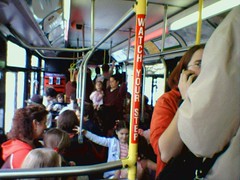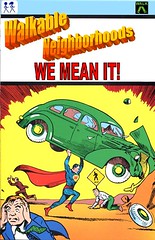The real relationship between driving and transit - are we becoming more sustainable, or not?

Posted January 26, 2009 at 1:33PM
The good news, as I've reported before, is that there are some very encouraging numbers: transit ridership is increasing dramatically, while overall vehicle travel remains in decline after decades of astounding growth.  Recent data show use of public transportation up 6.5 percent compared to the previous year, and national vehicle miles traveled down 4.5 percent, despite the sharp decline in gasoline prices.
Recent data show use of public transportation up 6.5 percent compared to the previous year, and national vehicle miles traveled down 4.5 percent, despite the sharp decline in gasoline prices.
But we shouldn't jump to the conclusion that all is well and will continue to be so without policy support and advocacy by those of us in the world of land use and sustainable development. In particular, we shouldn't conclude that simply adding more public transit, without also changing development patterns, will suffice to maintain the trends.
Robert Dunphy of the Urban Land Institute goes inside the numbers on the ULI blog The Ground Floor, concluding that the volume of transit increase represents a little less than a billion passenger-miles. But the decrease in driving amounts to much more, over 35 billion passenger-miles. So the drop in driving (and thus the carbon reduction benefit) is not primarily due to drivers switching to public transportation.  He quotes New York Times columnist Paul Krugman to the effect that, given the very small share of overall trips in the US currently claimed by transit, even a ten percent surge in transit use "would take only around half a percent of drivers off the road."
He quotes New York Times columnist Paul Krugman to the effect that, given the very small share of overall trips in the US currently claimed by transit, even a ten percent surge in transit use "would take only around half a percent of drivers off the road."
This brings me to a point that I believe is vital but that few environmental advocates ever acknowledge: we need growth patterns that shorten driving distances. Research that Eliot Allen of Criterion and I did in Nashville demonstrated that a more accessible (i.e., more central) neighborhood location reduced per capita greenhouse gas emissions from transportation around 25 percent, even though residents of the two neighborhoods studied took exactly the same number of driving trips per day and neither neighborhood had significant transit usage.
 We also need more walkable neighborhoods, where more of us can meet some of our needs without either driving or getting on public transportation.
We also need more walkable neighborhoods, where more of us can meet some of our needs without either driving or getting on public transportation.
Now, I don't want to be misunderstood: I am not arguing that we should back off one bit on our advocacy for transit. In fact, we should increase it, and I count myself on the team at NRDC for doing just that. But it's not enough. Here's Dunphy, referring to a survey last year by the firm NuStats:
"The survey suggests that the greatest potential for reduced driving lies not in expanding public transit to serve new riders, but to focus growth in areas where it supports established transit, where residents have options for shorter trips, combining trips, and walking, as well as public transit. In New York, for example, the Metropolitan Transportation Authority calls for land use strategies that will capture two-thirds of new VMTs in the region."
Put another way, land use change to support transit can be powerful. But transit without land use change will not take us where we need to go.